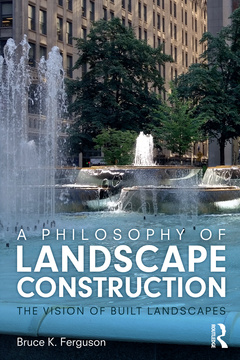A Philosophy of Landscape Construction The Vision of Built Landscapes
Auteur : Ferguson Bruce

A Philosophy of Landscape Construction outlines a philosophy of values in landscape construction, demonstrating how integral structures, such as pavements and walls, constitute a key element to how people interact with and inhabit the final design.
The book discusses how these structures enable, assist and care for people, negotiating between the dynamic processes of site ecosystems and the soil on which they are founded. They articulate spatial, functional, cultural and ecological meanings. Within this theoretical framework, designers will learn to recognize and insert a set of core values into the most technical design stages to reach their full potential.
By offering a new perspective on landscape construction, moving away from the exclusively technical characteristics, this book allows landscape architects to realise the ideal vision for their designs. It is abundantly illustrated with examples from which designers can learn both successes and failures and will be an essential companion to any study of built landscapes.
Preface; Why Now; What this Book Is Based On; How to Use this Book in Learning Landscape Construction; What this Book Is; Notes; Chapter 1. Introduction: The Call of Values; Built Landscapes and Landscape Construction; Values Waiting Within; The Yearning for Values in Construction Design; Your Aspiration and Your Development; Notes; Chapter 2. Between Structure and Vision; Pavement; Wall; Span; Structures in Interaction with Values; Notes; Chapter 3. Building toward People; Floors for Moving; Seats for Staying; Social orientation; Bodily comfort; Covers for Sheltering; The Importance of Durability; People in Built Landscapes; Notes; Chapter 4. Building toward Living Things; Living Soil; Spanning Structures; Inert Subgrade Soil; Permeable Structures; Rootable Structures; What is at stake; Structural soil; Return to spanning structures; Living Things around Structures; Living Things in Built Landscapes; Notes; Chapter 5. Building toward Meaning; Compositional Articulation; Functional Articulation; Cultural Articulation; Ecological Articulation; Meaning in Built Landscapes; Notes; Chapter 6. Building toward Thrift; Material Resources; Newly made materials; Previously made structures and materials; Financial Resources; Investment with exclusively financial values; Investment with multiple values; The Importance of Complete Investigation; Thrift in Built Landscapes; Notes; Chapter 7. The Open Way; A Drainage Outlet; Native in Material and Ecology; Evolution of Structures with Realization of Uses and Values; Pursuit of Values in the Act of Design; Notes; Chapter 8. Between Stone and Sky; Core Values; Specific Types of Values; Value Interactions and Priorities; Why Pause Now; Ideals: The Sky in the Stone; Notes
Bruce K. Ferguson is a landscape architect whose research, teaching, and practice have focused on the environmental and technical dimensions of urban design for four decades. He was formerly Franklin Professor and Director of the School of Environmental Design at the University of Georgia. He earned the AB degree at Dartmouth College and the MLA degree at the University of Pennsylvania. He is a Fellow of the American Society of Landscape Architects, a Past President of the Council of Educators in Landscape Architecture, and a recipient of the Council’s Outstanding Educator Award, North America’s highest award for career contributions to landscape architectural education.
Date de parution : 12-2020
15.6x23.4 cm
Date de parution : 12-2020
15.6x23.4 cm
Thèmes d’A Philosophy of Landscape Construction :
Mots-clés :
Soil’s Ecological Functions; Thin Outermost Layer; Landscape architects; Office Park Managers; Dynamic processes; Psychological Science; Landscape construction; Built Landscapes; Construction Design; Ecological site; Permeable Pavers; Landscape Structures; Natural Human Values; Rain Gardens; Living Soil; Detention Basins; Compositional Articulation; People’s Natural Moving; Energy Sources; Black Locust; Rooting Space; Traffic Calming; Construction Design Process; Original Natural Conditions; Functional Articulation; Fountain Basin; Impermeable Pavement; Seating Surface



